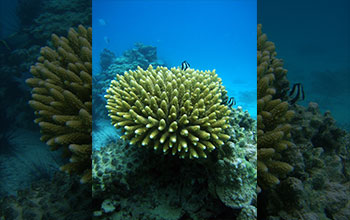Multimedia Gallery
Acropora retusa, a common species of coral
Acropora retusa, a common species of coral found throughout the world. Todd LaJeunesse of Pennsylvania State University and colleagues studied the effects of global warming on coral-algal symbioses in warm and cool waters.
More about this Image
Corals are colonies of tiny animals that acquire their nutrients and energy from golden-brown colored photosynthetic algae that live inside the coral's cells. This symbiotic relationship is sensitive to environmental change because the algae are photosynthetic, making them very sensitive to changes in light, and they are sensitive to changes in temperature as well. An increase in sea-surface temperature of just a few degrees for a period of several months can cause many of the coral-algal symbioses to break down and the algae to be expelled. This process is called bleaching because it leaves behind the clear animal tissue and the white skeleton underneath. High temperatures and low light availability can cause severe bleaching, and the corals soon die without their symbiotic partners.
As part of their research, LaJeunesse and colleagues surveyed corals living in the warm waters of the Andaman Sea and other regions around Southeast Asia. They were surprised to find a high diversity of corals living in inshore locations, where the water is quite warm and sometimes murky and the tidal influx so great, that many corals spend hours out of water, exposed to harsh sun and dry air.
In the Andaman Sea, the researchers identified a particularly abundant algae species that appears to be almost thermally tolerant, Symbiodinium trenchi. They found that the corals in symbiont with this species seem to tolerant higher levels of heat. LaJeunesse found the same species in the Caribbean Ocean during a bleaching event that took place in 2005. He says that S. trenchi, which are normally found in very low numbers in the Caribbean, took advantage of the warming event and become more prolific because of their apparent tolerance of high temperatures. "The species appears to have saved certain colonies of coral from the damaging effects of unusually warm water," said LaJeunesse.
In contrast, the team found very few algae species that are thermally tolerant in the western Indian Ocean and Great Barrier Reef areas, where the waters are cooler. LaJeunesse says that while S. trenchi and other related symbiont species can tolerate the Andaman Sea, where the water is on average three or four degrees warmer than the western Indian Ocean and Great Barrier Reef, if global warming causes water temperatures to warm further, even these species might not be able to handle it. On the other hand, LaJeunesse says that if the cooler waters of the western Indian Ocean and the barrier reef were to warm by three or four degrees, then S. trenchi could easily survive. The problem is that S. trenchi occur in very low numbers in these cooler areas and thus far, has not proliferated during bleaching events here the way it has in the Caribbean.
Some scientists have suggested that reefs with high-temperature waters could be seeded with the thermally tolerant S. trenchi; however, LaJeunesse questions the idea because S. trenchi form symbiotic associations only with corals and other animals that acquire their symbionts from the environment. Some species of coral are born with algae already in their cells, so while introducing S. trenchi into a new environment may help the species that acquire their symbionts, it would not affect the species born with algae already in their cells because these species have evolved special relationships with their algae. LaJeunesse also thinks there could be negative effects from introducing an organism into an ecosystem where it is not well established.
One thing is for certain. The bleaching caused by global warming may eventually lead to the demise of coral reef ecosystems and that, in turn, will have devastating effects on the tourism and food-fisheries industries. But LaJeunesse points out that the existence of so many novel coral symbioses thriving in a place that is too warm for most corals (the Andaman Sea) should give us hope that coral reefs and the ecosystems they support may persist--at least in some places--in the face of global warming. [This research was supported in part by National Science Foundation grant IOB 05-44854.] (Date of Image: 2007)
Credit: Todd LaJeunesse, Pennsylvania State University
Images and other media in the National Science Foundation Multimedia Gallery are available for use in print and electronic material by NSF employees, members of the media, university staff, teachers and the general public. All media in the gallery are intended for personal, educational and nonprofit/non-commercial use only.
Images credited to the National Science Foundation, a federal agency, are in the public domain. The images were created by employees of the United States Government as part of their official duties or prepared by contractors as "works for hire" for NSF. You may freely use NSF-credited images and, at your discretion, credit NSF with a "Courtesy: National Science Foundation" notation.
Additional information about general usage can be found in Conditions.
Also Available:
Download the high-resolution JPG version of the image. (4.7 MB)
Use your mouse to right-click (Mac users may need to Ctrl-click) the link above and choose the option that will save the file or target to your computer.

